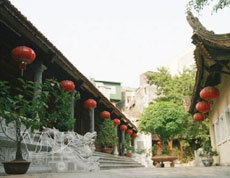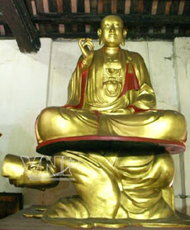
Present-day the pagoda is located in No 19, Hang Than Street, Ha Noi. The space of the pagoda is shaded by areca and lush green Bodhi trees.
The pagoda consists of two worshiping houses, each having five compartments, a sanctum with three compartments and an ancestor-worshipping chamber with seven compartments.
Standing on the pagoda’s ground are two three-storey towers and two large stone steles among 28 steles inside the pagoda.
A stele was built in the 24th Chinh Hoa Year (1703) under the reign of King Le Hy Tong (1675-1705) and clearly noted by Doctor Ho Tong Muc that the pagoda’s location was in Hoe Nhai Ward in Dong Bo Dau (the East Wharf).
The pagoda has now retained a bronze plaque, 1m high and 1.5m wide cast in the Year of the Tiger dated to the 3rd Long Duc Year (1631) under the reign of King Le Than Tong (1619-1643), a bronze drum cast in the Dynasty of King Tu Duc (1848-1883) and a series of statues made from precious woods and fumigated bronze.
Each statue has its own artistic value, lively depicting the portraits of new-born Sakyamuni, Amitabha Buddha and Avalokitesvara Bodhisattva, particularly Senior Monk Thich Duc Nhuan who glorified the Vietnamese Buddhism in the 20th century. However, the most salient characteristic of the pagoda is the statue of Buddha sitting on the back of a prostrating king.
It was said that the statue was sculpted in accordance with the legend of a king voluntarily prostrating to be the bed for Sakyamuni to sit to preach.

According to another the legend, King Le Hy Tong (1675-1705) applied a draconian code of ethics to Buddhism. Therefore, Most Venerable Chan Dun – the second Senior Monk in Hoe Nhai Pagoda, wrote a petition then put it in a casket to submit to the King. He said that there was a germ in the casket. When the King opened the casket, he did not see the germ but see a petition writing that the Le Dynasty (1428-1527) ruled the country for a long time thanks to Buddha’s assistance and protection. After that, King Le Hy Tong gave out an imperial decree showing his penitence and changed the policies on Buddhism. Then, the King asked to sculpt this statue to express his apology.
Hoe Nhai Pagoda is considered as the cradle of Soto sect (Tao Dong) which is one of the two main sects of Buddhism in the North of Viet Nam.
Hoe Nhai Pagoda had been repaired in large scale several times in 1687, 1899 and 1952. Recently, Hoe Nhai Pagoda is upgrading since it is one of important works which are repaired to prepare for grand ceremony of the 1000th anniversary Thang Long – Ha Noi in 2010.
With its artistic, ancient and religious value, Hoe Nhai Pagoda attracts a large number of visitors.
Phuong Anh (Edited)